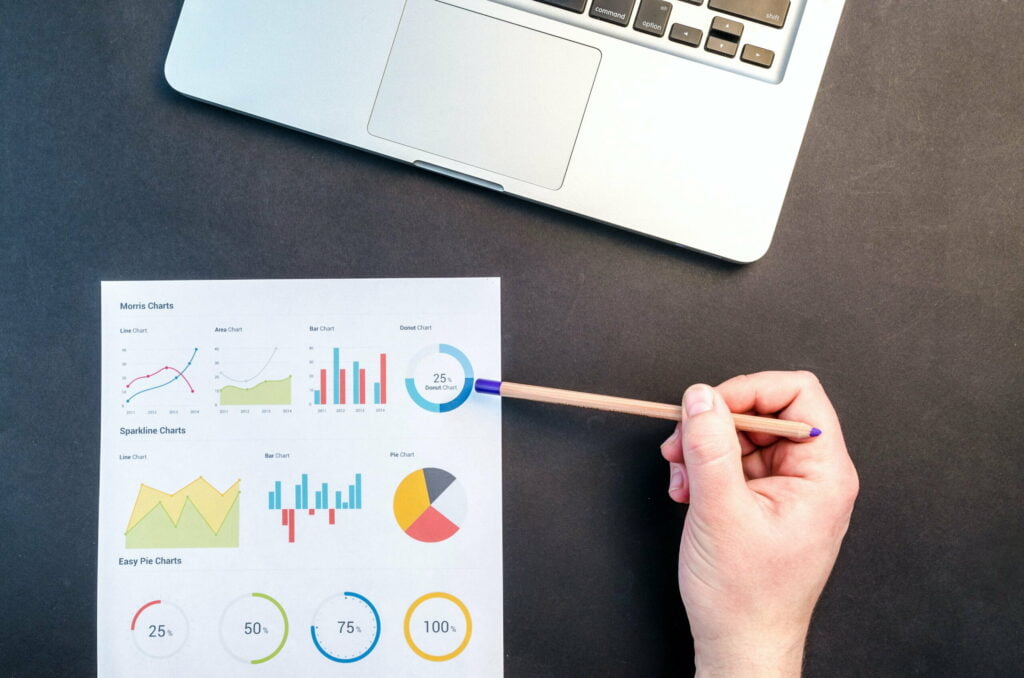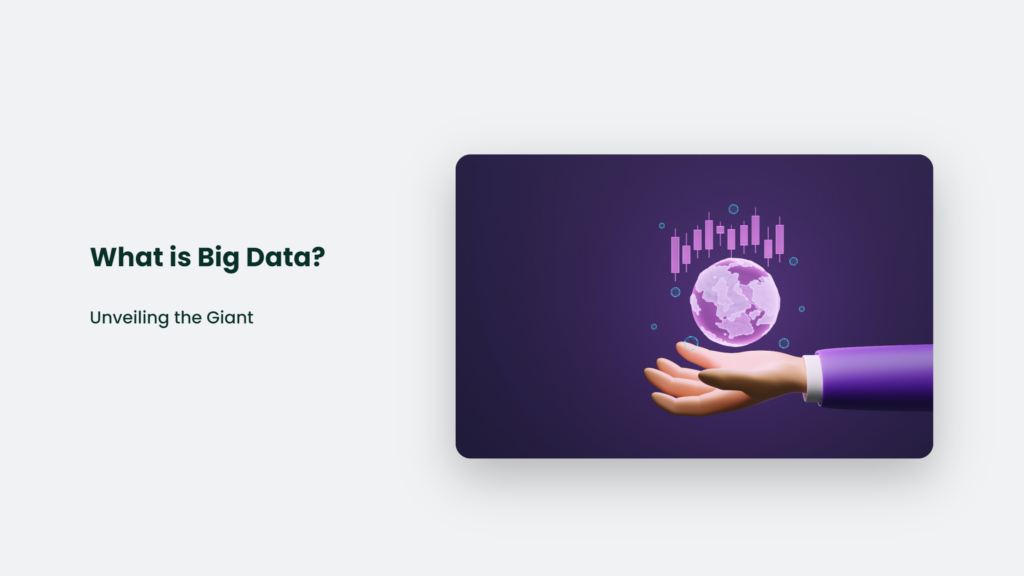

What is Big Data? Unveiling the Giant

As Seen On
In today’s digital age, “big data” is ubiquitous. Everyone seems to be talking about it, from tech enthusiasts to business moguls. But what is big data? How does it impact our lives, and why should we care? In this comprehensive guide, we will unravel the mysteries of big data, exploring its definition, real-world applications, and the profound influence it wields across diverse industries.

What is Big Data? More Than Just a Buzzword
At its core, big data refers to the vast volume of information that inundates businesses and society daily. This data comes from many sources, including sensors, social media posts, digital images, and purchase transactions. The sheer magnitude of this data is staggering, and traditional data processing applications are inadequate to deal with it. As a result, innovative technologies and analytical methods have emerged to make sense of this deluge of information.
The Three V’s of Big Data: Volume, Velocity, and Variety
To truly grasp the essence of big data, we must acquaint ourselves with the three defining characteristics: volume, velocity, and variety. These three V’s encapsulate the sheer scale, speed, and diversity of the data at hand, painting a vivid picture of its challenges and opportunities.
Volume:
Imagine the entire digital universe as an endless ocean of ones and zeros. Every day, we generate a mind-boggling 2.5 quintillion bytes of data. To put this into perspective, it’s equivalent to 250,000 Libraries of Congress, or the content of 5 million laptops stacked on each other reaching the moon. That’s big data in terms of volume!
Velocity:
The speed at which data is generated and processed is astounding. In the time it takes to read this sentence, thousands of tweets have been posted, and petabytes of data have traversed the internet’s vast network of interconnected devices. This breakneck pace of data flow is a hallmark of the digital era.
Variety:
Big data comes in diverse forms, from structured data in databases to unstructured data like text, images, and videos. This rich tapestry of data types presents a formidable challenge and a treasure trove of insights waiting to be unearthed.
Big Data in the Real World: Unleashing Its Potential
The impact of big data reverberates across a myriad of industries, revolutionising how businesses operate and how we tackle societal challenges. Let’s delve into some real-world examples that illustrate the transformative power of big data.
Healthcare: A Data-Driven Revolution
In the realm of healthcare, big data is a game-changer. By analysing large-scale patient data, healthcare providers can identify trends, predict disease outbreaks, and personalise treatment regimens with unprecedented precision. A study by McKinsey & Company revealed that big data analytics could reduce healthcare expenses in the US by $300 billion to $450 billion. That’s not just a drop in the bucket; it’s a seismic shift in the healthcare landscape.
Retail: Decoding Consumer Behavior
In retail, big data analytics empowers companies to decipher consumer preferences and anticipate trends. For instance, Amazon’s recommendation engine, powered by big data algorithms, drives a substantial portion of its sales, demonstrating the tangible impact of data-driven insights on consumer behaviour. It’s not mind-reading; it’s big data at work.
Transportation: Navigating the Data Highway
The transportation industry is also harnessing the potential of big data to optimise routes, enhance safety, and minimise environmental impact. For instance, using real-time traffic data and predictive analytics can reduce travel times by 15% to 20%. That’s not just a smoother ride; it’s a testament to the transformative power of big data in motion.
Common Misconceptions about Big Data:
Some common misconceptions about big data include:
- Big Data is Too Complex to Handle: In reality, big data tools and technologies are manageable with training and expertise, just like any other technology.
- Big Data is Costly: Publicly managed cloud platforms can provide cost-effective solutions, eliminating the need for hardware and software purchases.
- Big Data is for Big Enterprises Only: Big data, including affordable options like Hadoop, is accessible and useful for both small and large organisations.
- Big Data Can Predict Everything about the Future of the Business: While big data can provide insights, it does not guarantee precise business predictions.
- Big Data is Exclusive to Big Businesses: Small organisations can also harness the power of big data, as it is not exclusive to large enterprises.
- Big Data Provides Precise Answers: Big data provides patterned or generalised insights that require human interpretation rather than precise answers.
- Big Data is Just Hype: Big data is more than just a buzzword; it has tangible applications and impacts across various industries.
- Big Data is Magic: Big data does not come with a magic easy button to push that delivers a competitive advantage or insights. It requires skilled individuals and organisational support to be effective.
- Big Data is Always Quality Data: Big data does not necessarily mean it contains clean and quality data. It usually includes data quality errors and requires cleaning to leverage better insights.
- Big Data Can Be Used to Predict Everything about the Future: While big data can provide valuable insights, it cannot predict everything about the future of a business.
These misconceptions highlight the need for a clear understanding of big data, its capabilities, and the importance of leveraging it responsibly and effectively.
Big Data to Improve Customer Experience:
Businesses can leverage big data to enhance customer experience in several ways. Here are some insights on how big data can be used to improve customer experience:
- Personalisation: Big data allows businesses to treat every customer interaction as a data point, enabling personalised experiences tailored to individual preferences and behaviours.
- Reducing Friction: By understanding and analysing customer behaviour, businesses can identify pain points in the customer journey and streamline processes to reduce friction, leading to a smoother and more satisfying experience.
- Understanding Customer Behavior: Big data enables businesses to gain deep insights into customer behaviour, preferences, and pain points, allowing them to tailor their products and services to meet Customer needs better.
- Interpreting Shopper’s Behavior: By observing behaviour patterns and conducting sentiment analysis, businesses can better understand customer preferences and tailor their offerings accordingly.
- Predicting Customer Needs: Big data empowers businesses to predict customer needs, enabling proactive resolution of issues, personalised solutions, and fine-tuning strategies based on customer feedback.
- Proactive Issue Resolution: In industries like manufacturing and technology, big data can help predict when products or equipment might require maintenance or upgrades, ensuring a more reliable and satisfactory customer experience.
By harnessing the power of big data, businesses can create more personalised, seamless, and proactive customer experiences, ultimately driving customer satisfaction and loyalty.
The Future of Big Data: Navigating Uncharted Territory
As we stand on the cusp of a data-driven future, big data’s possibilities and perils loom. The exponential growth of data presents unprecedented opportunities for innovation, but it also raises profound questions about privacy, security, and ethical use. In the words of renowned data scientist DJ Patil, “The best minds of my generation are thinking about how to make people click ads. That sucks”. It’s a stark reminder of the ethical dimensions that underpin the big data revolution.
Unraveling the Ethical Quandaries
The ethical implications of big data are a double-edged sword. On the one hand, it can drive social good, from predicting and preventing diseases to mitigating climate change. On the other hand, it raises concerns about data privacy, algorithmic bias, and the erosion of personal autonomy. As we hurtle into an era defined by data, striking a balance between innovation and ethics is paramount.
Frequently Asked Questions:
What are the main challenges of big data?
The main challenges of big data revolve around its volume, velocity, and variety. The key challenges are managing and analyzing vast amounts of data in real-time, dealing with diverse data types, and ensuring data security and privacy.
How is big data used in business?
In business, big data is used for various purposes, including customer analytics, operational optimization, risk management, and product development. It enables companies to make data-driven decisions and gain competitive advantages.
What are the ethical concerns related to big data?
Ethical concerns related to big data include data privacy, security, algorithmic bias, and the potential misuse of personal information. Balancing the benefits of big data with ethical considerations is a critical issue in the digital age.
Embracing the Data Deluge
In conclusion, big data is not merely a buzzword; it’s a seismic force reshaping our world’s contours. From healthcare to retail and beyond, the influence of big data is pervasive and profound. As we navigate the data deluge, harnessing its potential responsibly is imperative, ensuring that the benefits are equitably distributed, and the ethical guardrails are firmly in place. The future is data-driven, and our choices will reverberate for generations to come.
Konger
Up until working with Casey, we had only had poor to mediocre experiences outsourcing work to agencies. Casey & the team at CJ&CO are the exception to the rule.
Communication was beyond great, his understanding of our vision was phenomenal, and instead of needing babysitting like the other agencies we worked with, he was not only completely dependable but also gave us sound suggestions on how to get better results, at the risk of us not needing him for the initial job we requested (absolute gem).
This has truly been the first time we worked with someone outside of our business that quickly grasped our vision, and that I could completely forget about and would still deliver above expectations.
I honestly can't wait to work in many more projects together!
Disclaimer
*The information this blog provides is for general informational purposes only and is not intended as financial or professional advice. The information may not reflect current developments and may be changed or updated without notice. Any opinions expressed on this blog are the author’s own and do not necessarily reflect the views of the author’s employer or any other organization. You should not act or rely on any information contained in this blog without first seeking the advice of a professional. No representation or warranty, express or implied, is made as to the accuracy or completeness of the information contained in this blog. The author and affiliated parties assume no liability for any errors or omissions.

